The AMD Ryzen 5 1600X vs Core i5 Review: Twelve Threads vs Four at $250
by Ian Cutress on April 11, 2017 9:00 AM ESTBenchmarking Performance: CPU Web Tests
One of the issues when running web-based tests is the nature of modern browsers to automatically install updates. This means any sustained period of benchmarking will invariably fall foul of the 'it's updated beyond the state of comparison' rule, especially when browsers will update if you give them half a second to think about it. Despite this, we were able to find a series of commands to create an un-updatable version of Chrome 56 for our 2017 test suite. While this means we might not be on the bleeding edge of the latest browser, it makes the scores between CPUs comparable.
SunSpider 1.0.2 [link]
The oldest web-based benchmark in this portion of our test is SunSpider. This is a very basic javascript algorithm tool, and ends up being more a measure of IPC and latency than anything else, with most high performance CPUs scoring around about the same. The basic test is looped 10 times and the average taken. We run the basic test 4 times.
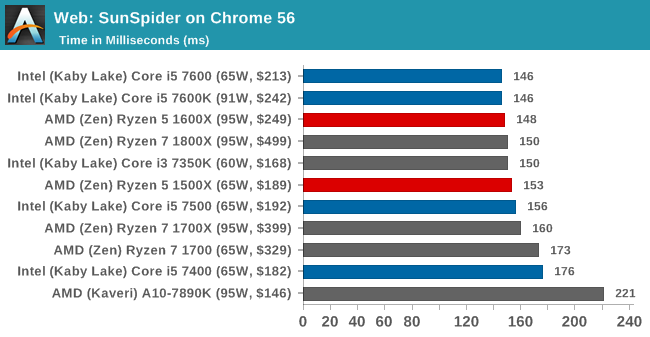
Mozilla Kraken 1.1 [link]
Kraken is another Javascript based benchmark, using the same test harness as SunSpider, but focusing on more stringent real-world use cases and libraries, such as audio processing and image filters. Again, the basic test is looped ten times, and we run the basic test four times.
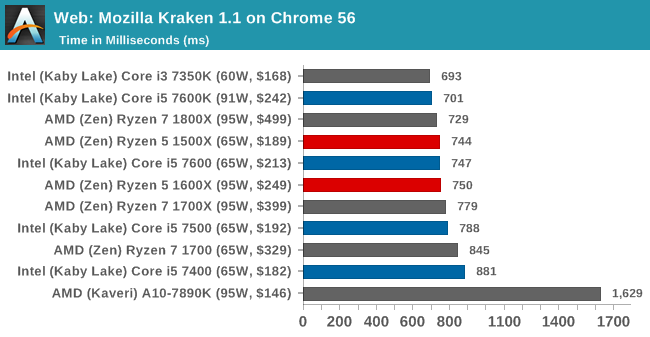
Google Octane 2.0 [link]
Along with Mozilla, as Google is a major browser developer, having peak JS performance is typically a critical asset when comparing against the other OS developers. In the same way that SunSpider is a very early JS benchmark, and Kraken is a bit newer, Octane aims to be more relevant to real workloads, especially in power constrained devices such as smartphones and tablets.
WebXPRT 2013 and 2015 [link]
While the previous three benchmarks do calculations in the background and represent a score, WebXPRT is designed to be a better interpretation of visual workloads that a professional user might have, such as browser based applications, graphing, image editing, sort/analysis, scientific analysis and financial tools. Web2013 is the older tool, superceded by Web2015, however both still are highly relevant for high-performance web applications today.
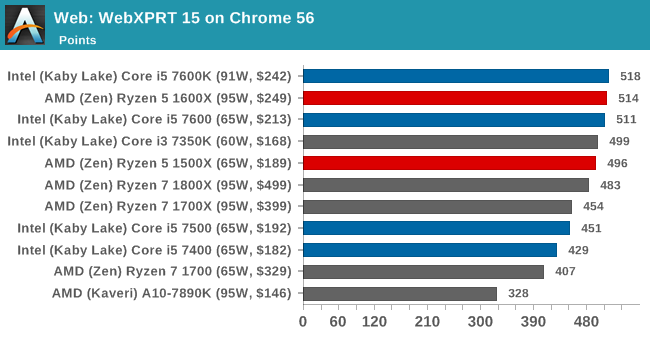


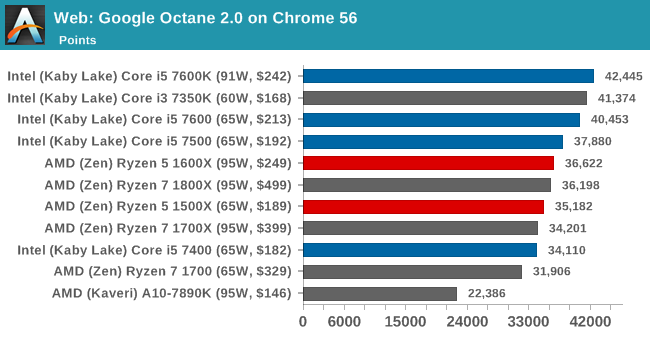
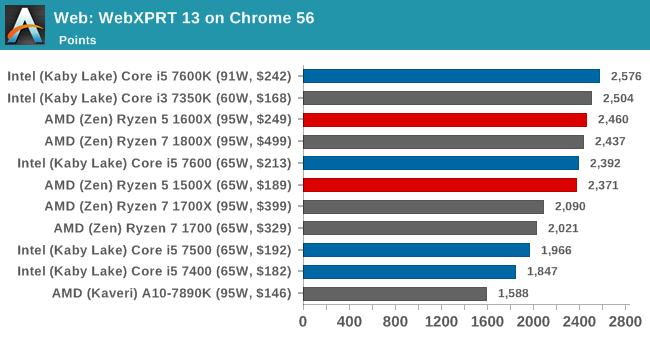








254 Comments
View All Comments
Meteor2 - Wednesday, April 12, 2017 - link
I think exact the same thing: R5 1600 + RX580 is going to be unbeatable value for money.deltaFx2 - Tuesday, April 11, 2017 - link
@Ian Cutress: It would be helpful to know whether any of the workloads above use AVX-256, just to know how prevalent they are in common code. For example, does your 3DPM code use AVX-256? Also, when you run legacy tests, are the binaries legacy too, or do you recompile when applicable?beerandcandy - Wednesday, April 12, 2017 - link
This looks like it might be a good start for AMD to get back in the game. This isn't the normal way you try to do these things. I think mostly you want to show your best CPU "DESTROY" the competitors best CPU. If AMD doesn't do that then it sucks because they wont be able to compete in the halo CPU product areas. This will also cause them to be in a limited market space and they will be forced into less profitable situationspandemonium - Wednesday, April 12, 2017 - link
I am curious why comparable Intel 2011-3 CPUs weren't included? The i7-6800k would be in nearly direct competition to the 1800X based on cores and MSRP.ET - Wednesday, April 12, 2017 - link
Thanks for the comprehensive testing. I was missing some Core i7 results for comparison in some tests, such as the compilation test.Lechelou - Wednesday, April 12, 2017 - link
Leonard Nimoy voiced Civ IV, not V. Just sayin'.madwolfchin - Wednesday, April 12, 2017 - link
Someone at AMD should rethink about the position of R7 1700 vs R5 1600X, The 1600X is faster in Single Tread, and about even with the 1700 in multi-threaded application. Why would anyone buy the 1700 which is much more expensiveOutlander_04 - Wednesday, April 12, 2017 - link
Because you can OC it and have the same performance as an 1800XMeteor2 - Wednesday, April 12, 2017 - link
I've only read as far as the test-bed set-up page: I want to say a MASSIVE thank you to MSI for supplying the GTX1080s. Top stuff, and that won't be forgotten.Back to reading...
vladx - Wednesday, April 12, 2017 - link
Wow so Anandtech have now turned into AMD shills. Not only you conveniently excluded or ignored the 7700k, but also skipped the 7600k from the gaming benchmarks to paint Ryzen in a better light than reality actually reflects.I understand you had to finish the article ASAP but Anandtech was all about quality articles and you really should've published the article when you had all the facts.